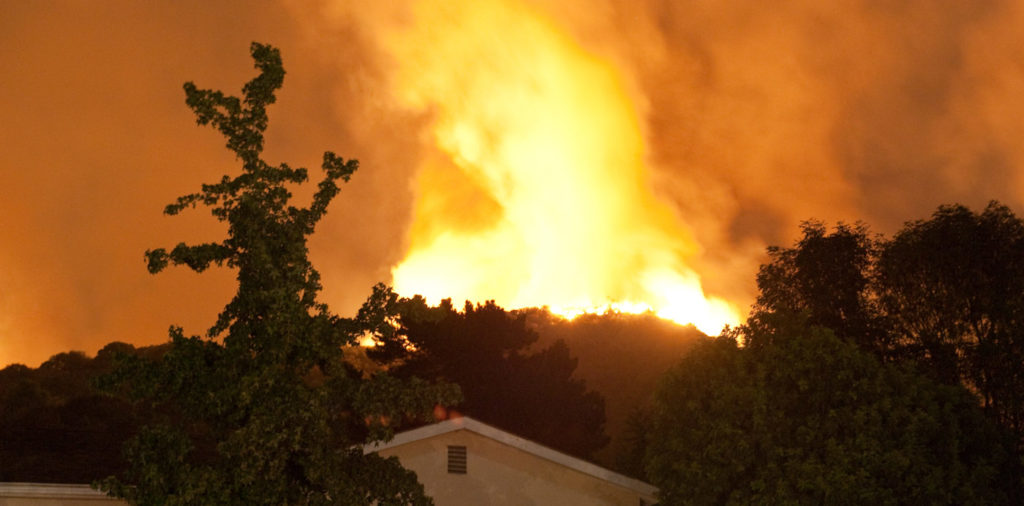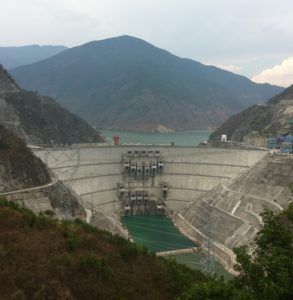From the extreme storms in the Atlantic and Gulf coasts to historic fires in the West, the United States is facing the impacts of climate change firsthand. As people flee from ecological disasters, the U.S. faces questions about how to respond to climate displacement, both in the form of evacuation and long-term climate migration. To effectively safeguard its citizens from the climate crisis, the U.S. must follow sound science.
The 2020 wildfire season in California, Oregon and Washington is the worst on record. Millions of acres are on fire, costing lives and forcing tens of thousands to flee their homes, leaving possessions and livelihoods behind. The construction of homes in the wildland-urban interface, at the edge of expanding urban areas, represents an immense challenge. A recent study found that an average of 2.5 million homes are now threatened every year by wildfires.
On the East Coast, and for only the second time in recorded history, five tropical cyclones are in the Atlantic Ocean at the same time. Hurricane Sally, the second storm in less than a month to threaten the Gulf Coast, brought “extreme life-threatening flash flooding,” according to the National Hurricane Center. The COVID-19 pandemic is also complicating both pre and post disaster planning, with social distancing guidelines cutting shelter capacity by as much as 60 percent.
Both of these environmental catastrophes are linked to climate change. Although most fires are started by humans, climate-related factors such as hotter temperatures and increasingly severe droughts exacerbate fire risk. Fires start earlier in the year, last longer and cause more damage. In California, an intense heat wave led to the hottest August on record. During a severe drought between 2012 and 2016, an estimated 150 million trees died in California, providing additional fuel for the wildfires.
Hurricane Sally was slow moving, at a mere two miles per hour. The drop of hurricane speed that we’ve seen in past years with Hurricane Harvey, Florence and Dorian is partly attributed to warming waters and triggered by climate change. This slowdown is causing more severe rainfall, and coupled with sea level rise, is increasing the risk of major storm surge and flooding. A 2018 study found that since the 1950s, the speed of tropical storms had decreased by about 10 percent globally.
Our planet is facing increasingly severe weather-related disasters with each passing year. And as a result, more people are forced to flee their homes. In 2018, 1.2 million Americans were displaced because of weather-related disasters. As the impacts of climate change increase, this figure is expected to rise with it.
While migration is a complex phenomenon, it is undeniable that climate change is an increasingly important driver. It degrades livelihoods, human health and security, and the health of ecosystems — on which we all depend.
Displacement patterns can be seen across the world. In the Lake Chad Basin of Central Africa, climate change, increasing demand for water and hydrological changes have caused the lake to shrink by more than 90 percent. This has severely impacted the million people who rely on this resource for their livelihoods, resulting in poverty and forcing migration.
This summer, torrential rains flooded more than a quarter of Bangladesh along the River Brahmaputra. These floods ruined an estimated one million homes, impacting 4.7 million people and claiming the lives of at least 100 people, most of whom were children. Faced with this reality, many Bangladesh citizens are migrating to India.
In the face of the climate crisis and growing displacement, we need leaders who will work with the scientific community to develop solutions. Ignoring the reality of climate change is not the answer. Strong voices are needed to offer clarity to communities about the immediate impacts of climate change to their everyday lives. Connecting climate change to personal health and economic wellbeing is critical to gain buy in for the difficult — but necessary — actions.
The U.S. needs to prioritize both international and domestic climate action. We need to rejoin the Paris Climate Agreement and work with major global powers like China and the European Union to protect global biodiversity and devise nature-based solutions. This includes supporting resilience funding for emerging economies and small island developing states, who are disproportionately affected by climate change and least equipped to respond.
On the domestic front, promoting new technology, ensuring a transition towards a green economy and meeting net zero carbon goals are critical. To build resilience for communities at threat from climate displacement, planning must target vulnerable citizens and critical infrastructure. It is estimated that for every dollar invested by the U.S. federal government before a disaster saves $6 dollars in recovery. As climate change intensifies, planning for a “managed retreat” to move people out of harm’s way should also be considered.
While cities and states can take effective action, more needs to be done, especially on the federal level. While integrated resilience planning is highly context specific, actions at the local level need to be guided through a coordinated national strategy.
Recent events in the U.S. underscore the need for leadership and targeted investment to address the climate crisis, safeguard citizens and build resilience where it is needed most. Without leadership and immediate action, climate displacement will only grow, and it will devastate individuals, families and communities around the world.
This article was originally published in The Hill.




